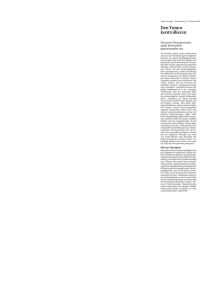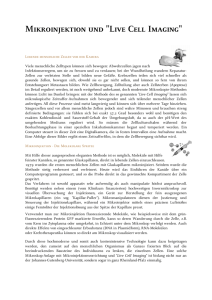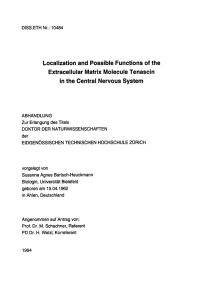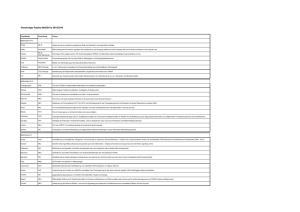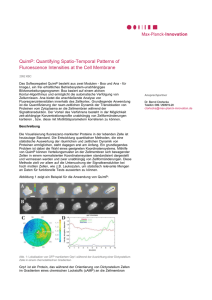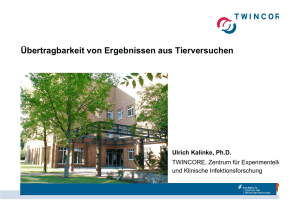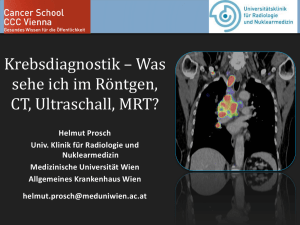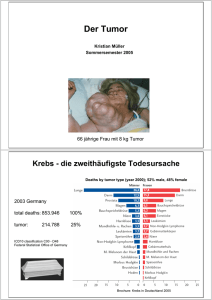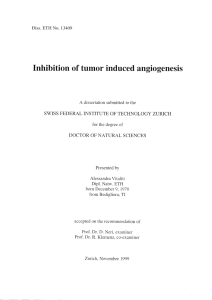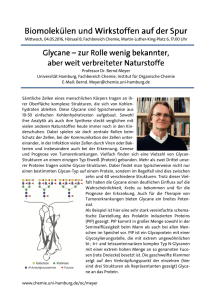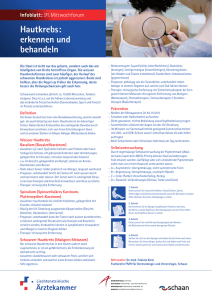Investigating the role of activated leukocyte cell - ETH E
Werbung
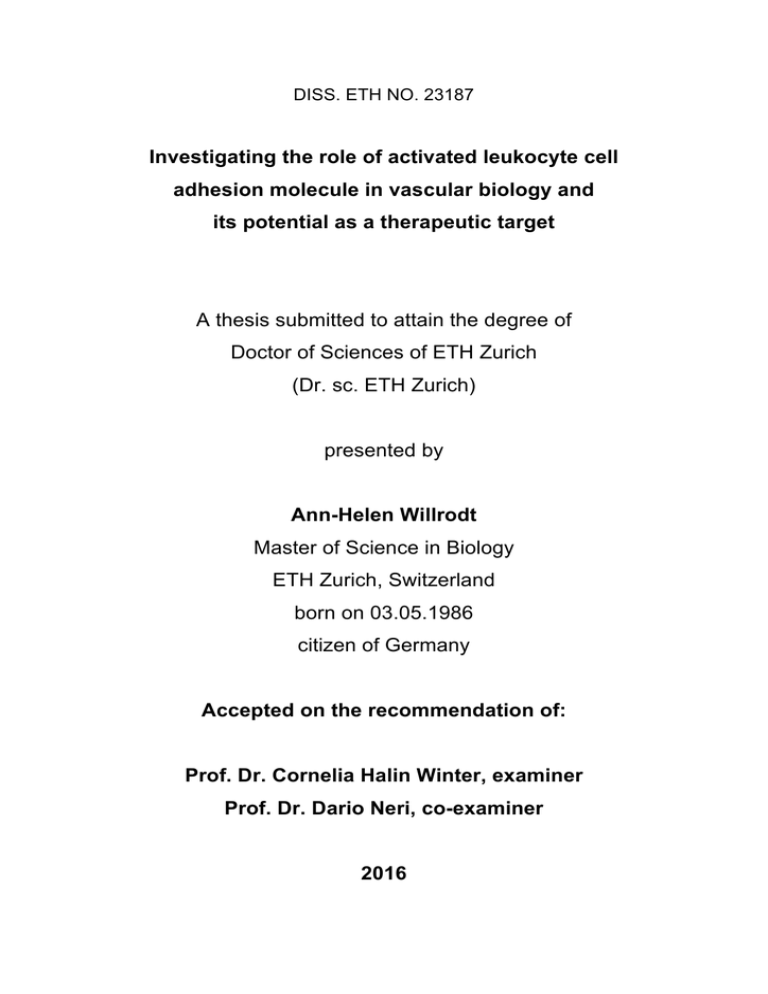
DISS. ETH NO. 23187 Investigating the role of activated leukocyte cell adhesion molecule in vascular biology and its potential as a therapeutic target A thesis submitted to attain the degree of Doctor of Sciences of ETH Zurich (Dr. sc. ETH Zurich) presented by Ann-Helen Willrodt Master of Science in Biology ETH Zurich, Switzerland born on 03.05.1986 citizen of Germany Accepted on the recommendation of: Prof. Dr. Cornelia Halin Winter, examiner Prof. Dr. Dario Neri, co-examiner 2016 1 Summary 1.1 Summary Besides its physiological function, the vascular system is involved in a variety of different diseases. Therefore, it is crucial to understand the underlying mechanisms leading to the formation and function of the vasculature under physiological and pathological conditions. Vertebrates have developed two vascular systems, which work in concert to ensure tissue homeostasis of the highly complex vertebrate body. The blood vascular system is a closed circuit with a hierarchical network, which allows the efficient distribution of gases, nutrients and cells throughout the vertebrate body. The lymphatic vascular system, on the other hand, is based on blind-ended capillaries, which drain fluid and immune cells through lymphatic collectors to tissue-draining lymph nodes and finally back into the blood circulation. Cell adhesion molecules are transmembrane proteins, which are involved in cell-cell and cell-matrix interactions. Upon interaction with their ligands a variety of different cellular processes are induced, which are also important for vascular development and vessel stability. The activated leukocyte cell adhesion molecule (ALCAM) is a molecule expressed by both vascular systems, and its overexpression by tumor cells has been correlated with poor survival of cancer patients, making it an interesting therapeutic target. ALCAM is an adhesion molecule of the immunoglobulin superfamily with reported expression on various leukocyte subsets, neurons, certain epithelial cells and vascular endothelium. Analyses of ALCAM function have shown that it is involved in cell differentiation, dynamic growth and migration. Furthermore, it was reported to be involved in diverse cellular processes, such as T cell activation, tumor invasion, neuronal and endothelial cell biology. In the first project, we investigated the role of ALCAM in tumor growth. To this end, in vivo lung metastasis models were performed using three different tumor cell lines. We could show that ALCAM deficiency resulted in reduced tumor burden in all three models tested. Furthermore, the reduced tumor progression was shown to be in part due to a defect in tumor-associated angiogenesis. 1 Because ALCAM deficiency led to a striking reduction in tumor growth, we wanted to investigate ALCAM`s potential as a therapeutic target. Therefore, we engineered and characterized the ALCAM-blocking antibody scFv I/F8-Fc. We could confirm its ability to specifically bind and block murine ALCAM. In addition, functional in vitro assays demonstrated that the antibody could interfere with (lymph-) angiogenic processes. Performing a developmental blocking study in vivo, we could show its ability to interfere with the formation of lymphatic vessels in the diaphragm and blood vessels in the retina. In the third study, the role of ALCAM in immune-mediated diseases such as contact hypersensitivity and asthma was investigated. Functional in vitro assays confirmed that ALCAM contributes to dendritic cell transmigration, as well as to T cell activation. In addition, in both mouse models of immunemediated inflammation, ALCAM-deficient mice showed a reduced immune response. Collectively, the results of this thesis provide new insights into the role of ALCAM in vascular biology and immune-mediated diseases and provide a rational for therapeutic blockade of ALCAM in diseases associated with vascular expansion and/ or an over response of the immune system. 2 1.2 Zusammenfassung Neben seiner menschlichen physiologischen Körpers in der Funktion ist Entstehung das Gefäßsystem verschiedener des Krankheiten involviert. Aus diesem Grund ist es von großer Bedeutung die Mechanismen zu erforschen, welche zur Bildung von Gefäßen unter physiologischen und pathologischen Bedingungen führen. Wirbeltiere haben zwei Gefäßsysteme entwickelt, welche über den gesamten Organismus verteilt sind und unter physiologischen Bedingungen die Homöostase des Körpers garantieren. Die Hauptaufgabe des Blutgefäßsystems ist die Sauerstoff- und Energieversorgung aller Zellen im Organismus. Um dies sicherstellen zu können, pumpt das Herz sauerstoff- und nährstoffreiches Blut durch den weit verzweigten Blutkreislauf. Im Gegensatz dazu bilden Lymphgefäße keinen geschlossenen Kreislauf. Lymphgefäße in peripheren Geweben nehmen Gewebeflüssigkeit, Zellen und Makromoleküle auf, welche sie über Lymphknoten zurück in das Blutgefäßsystem transportieren. Zelladhäsionsmoleküle sind transmembrane Proteine, welche zum einen Interaktionen von Zellen miteinander und zum anderen Interaktionen von Zellen mit der extrazellularen Matrix des Gewebes vermitteln. Eine derartige Interaktion zwischen Zelladhäsionsmolekülen und ihren Liganden induziert eine Vielzahl an verschiedensten Zellprozessen, welche unter anderem bei der Entwicklung von Gefäßen eine zentrale Rolle spielen. Das Aktivierte Leukozyten Zelladhäsionsmolekül (ALCAM) ist ein Molekül, welches von Zellen beider Gefäßsysteme exprimiert wird. Die Tatsache, dass für einige Krebsarten eine erhöhte ALCAM Expression mit einer geringeren Überlebenschance der Krebspatienten korreliert, interessanten therapeutischen Ansatzpunkt. macht es zu einem ALCAM ist ein Adhäsions- molekül der Immunglobulin-Superfamilie, dessen Expression in einer Vielzahl von verschiedensten Zellen gezeigt worden ist. Unter anderem wird ALCAM von Immunzellen, Nervenzellen, bestimmten Epithelzellen und Endothelzellen exprimiert. Die Forschung hat gezeigt, dass ALCAM in Prozesse wie der Zelldifferenzierung, dem dynamischen Wachstum und der Migration involviert ist. Des Weiteren wurde gezeigt, dass ALCAM eine wichtige Rolle bei der T- 3 Zell Aktivierung, der Tumorinvasion, sowie der neuronalen und vaskuläre Zellbiologie spielt. Im ersten Projekt der Doktorarbeit wurde die Rolle von ALCAM im Tumorwachstum untersucht. Mittels drei verschiedener LungenmetastasenModelle konnten wir zeigen, dass ALCAM Knockout Mäuse (ALCAM-/-) gegenüber Wildtyp (WT) Mäusen ein geringeres Tumorwachstum aufweisen. Wir konnten zeigen, dass das geringere Tumorwachstum zum Teil durch einen Defekt in der Neubildung von Tumor-assoziierten Blutgefäßen verursacht wurde. Da ALCAM-/- Mäuse ein geringeres Tumorwachstum aufweisen, war das Ziel des zweiten Projektes, ALCAM hinsichtlich seines therapeutischen Potenzials zu testen. Hierfür wurde ein Antikörper gegen ALCAM generiert und charakterisiert. Wir konnten bestätigen, dass der anti-ALCAM Antikörper scFv I/F8-Fc humanes und murines ALCAM spezifisch bindet und blockiert. Des Weiteren konnten wir mittels in vitro Experimenten zeigen, dass der Antikörper in der Lage ist Prozesse zu blockieren, welche für die (Lymph-) Angiogenese wichtig sind. Abschließend konnten wir die in vivo Aktivität des Antikörpers in einem Entwicklungsmodel bestätigen. Mäuse, welche während ihrer Entwicklung dem blockierenden ALCAM Antikörper scFv I/F8-Fc ausgesetzte waren, wiesen ein reduziertes Lymphgefäßsystem im Zwerchfell und Blutgefäßsystem in der Retina auf. Im dritten Projekt wurde der Einfluss von ALCAM in der Entstehung von Krankheiten, in denen das Immunsystem eine zentrale Rolle spielt, untersucht. Mit Hilfe von in vitro Experimenten konnten wir zunächst bestätigen, dass ALCAM eine Rolle bei der Transmigration von dendritischen Zellen und der Aktivierung von T-Zellen spielt. Anschließend wurde die Rolle von ALCAM in der Entwicklung von Asthma und der allergischen Kontaktdermatitis untersucht. In beiden getesteten Modellen zeigten ALCAM-/Mäuse im Vergleich zu WT Mäusen eine reduzierte Immunantwort. Zusammenfassend konnten wir zeigen, dass ALCAM eine wichtige Rolle in der vaskulären Biologie, sowie der Entwicklung einer Immunantwort spielt. Aus diesem Grund stellen unsere Forschungsergebnisse eine Grundlage für die therapeutische Blockierung von ALCAM in pathologischen Prozessen, 4 welche auf der Expansion des Gefäßsystems oder der Überreaktion des Immunsystems basieren, da. 5
